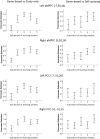Gamification of Learning Deactivates the Default Mode Network
- PMID: 26779054
- PMCID: PMC4705349
- DOI: 10.3389/fpsyg.2015.01891
Gamification of Learning Deactivates the Default Mode Network
Abstract
We hypothesized that embedding educational learning in a game would improve learning outcomes, with increased engagement and recruitment of cognitive resources evidenced by increased activation of working memory network (WMN) and deactivation of default mode network (DMN) regions. In an fMRI study, we compared activity during periods of learning in three conditions that were increasingly game-like: Study-only (when periods of learning were followed by an exemplar question together with its correct answer), Self-quizzing (when periods of learning were followed by a multiple choice question in return for a fixed number of points) and Game-based (when, following each period of learning, participants competed with a peer to answer the question for escalating, uncertain rewards). DMN hubs deactivated as conditions became more game-like, alongside greater self-reported engagement and, in the Game-based condition, higher learning scores. These changes did not occur with any detectable increase in WMN activity. Additionally, ventral striatal activation was associated with responding to questions and receiving positive question feedback. Results support the significance of DMN deactivation for educational learning, and are aligned with recent evidence suggesting DMN and WMN activity may not always be anti-correlated.
Keywords: default mode network; memory; reward; working memory.
Figures





Similar articles
-
Biophysical mechanism of the interaction between default mode network and working memory network.Cogn Neurodyn. 2021 Dec;15(6):1101-1124. doi: 10.1007/s11571-021-09674-1. Epub 2021 Apr 19. Cogn Neurodyn. 2021. PMID: 34786031 Free PMC article.
-
Coactivation of the Default Mode Network regions and Working Memory Network regions during task preparation.Sci Rep. 2014 Aug 5;4:5954. doi: 10.1038/srep05954. Sci Rep. 2014. PMID: 25092432 Free PMC article.
-
Is a Responsive Default Mode Network Required for Successful Working Memory Task Performance?J Neurosci. 2015 Aug 19;35(33):11595-605. doi: 10.1523/JNEUROSCI.0264-15.2015. J Neurosci. 2015. PMID: 26290236 Free PMC article. Clinical Trial.
-
Neural underpinnings of background acoustic noise in normal aging and mild cognitive impairment.Neuroscience. 2015 Dec 3;310:410-21. doi: 10.1016/j.neuroscience.2015.09.031. Epub 2015 Sep 29. Neuroscience. 2015. PMID: 26391923
-
Subcortical control of the default mode network: Role of the basal forebrain and implications for neuropsychiatric disorders.Brain Res Bull. 2022 Jul;185:129-139. doi: 10.1016/j.brainresbull.2022.05.005. Epub 2022 May 11. Brain Res Bull. 2022. PMID: 35562013 Free PMC article. Review.
Cited by
-
Rest to Promote Learning: A Brain Default Mode Network Perspective.Behav Sci (Basel). 2024 Apr 22;14(4):349. doi: 10.3390/bs14040349. Behav Sci (Basel). 2024. PMID: 38667145 Free PMC article. Review.
-
ADHD-Gaming Disorder Comorbidity in Children and Adolescents: A Narrative Review.Children (Basel). 2022 Oct 6;9(10):1528. doi: 10.3390/children9101528. Children (Basel). 2022. PMID: 36291464 Free PMC article. Review.
-
Effects of Gamification on Student Success and Perception of Instruction in Neuroanatomy: A Retrospective Analysis.J Undergrad Neurosci Educ. 2024 Dec 24;23(1):A1-A8. doi: 10.59390/XSMV4309. eCollection 2024 Fall. J Undergrad Neurosci Educ. 2024. PMID: 39810962 Free PMC article.
-
Abnormal brain activation during speech perception and production in children and adults with reading difficulty.NPJ Sci Learn. 2024 Aug 24;9(1):53. doi: 10.1038/s41539-024-00266-2. NPJ Sci Learn. 2024. PMID: 39181867 Free PMC article.
-
Game-based learning environments affect frontal brain activity.PLoS One. 2020 Nov 19;15(11):e0242573. doi: 10.1371/journal.pone.0242573. eCollection 2020. PLoS One. 2020. PMID: 33211780 Free PMC article.
References
-
- All A., Nuñez Castellar E. P., Van Looy J. (2015). Towards a conceptual framework for assessing the effectiveness of digital game-based learning. Comput. Educ. 88 29–37. 10.1016/j.compedu.2015.04.012 - DOI
LinkOut - more resources
Full Text Sources
Other Literature Sources

